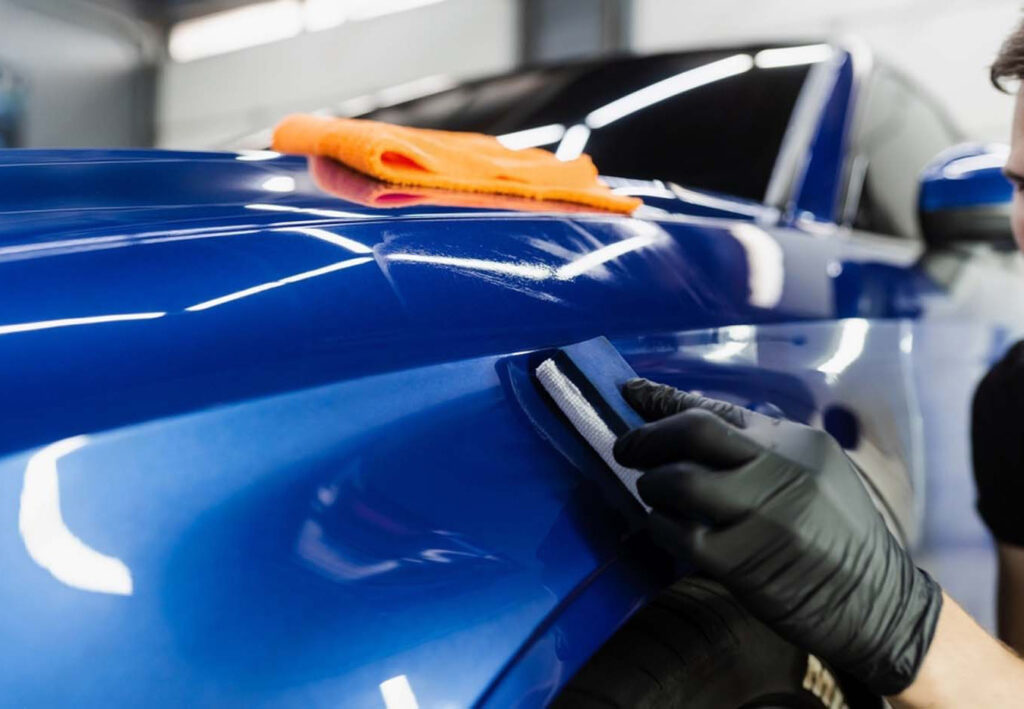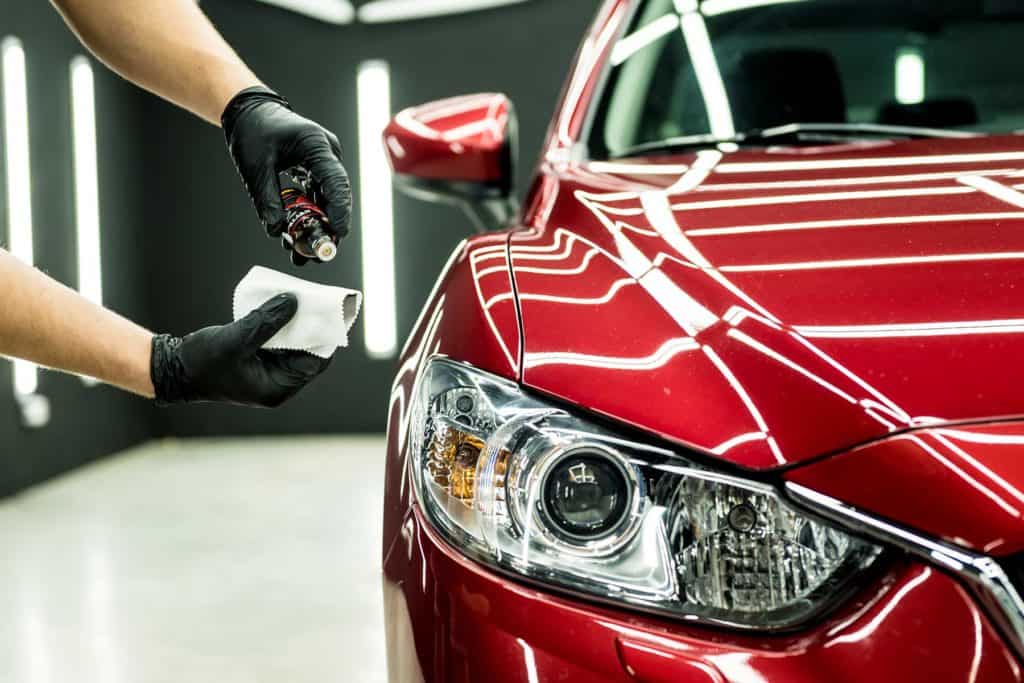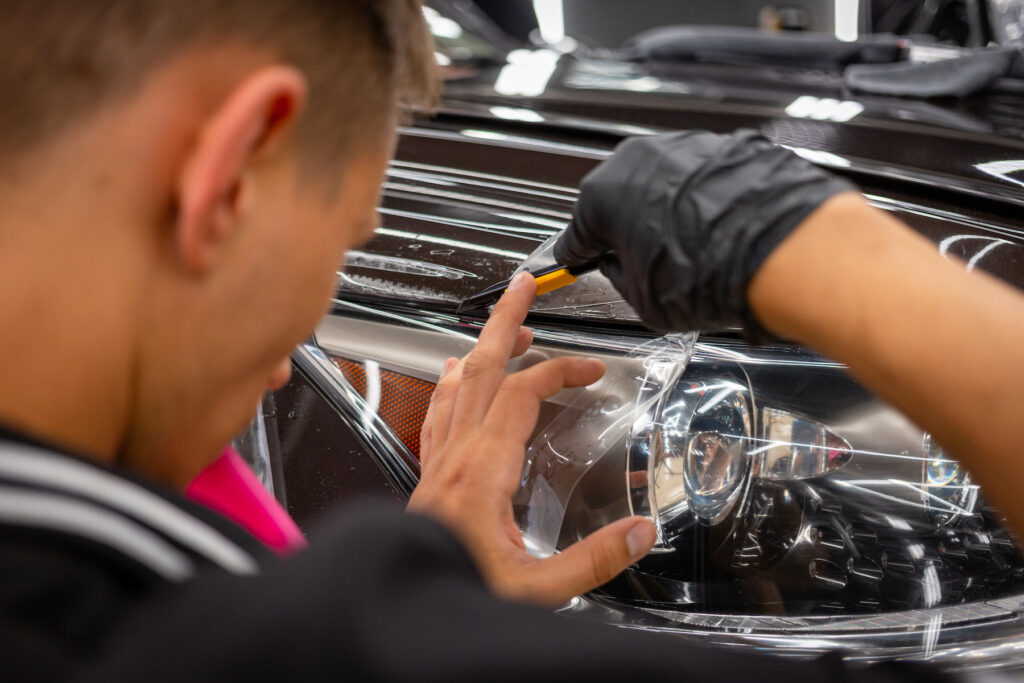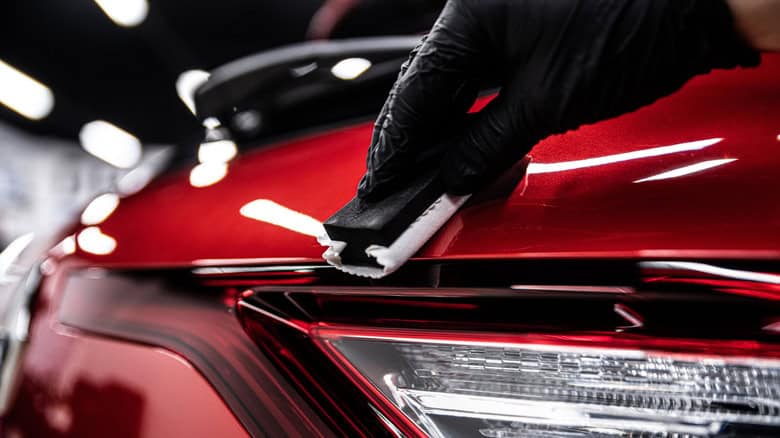In the world of automotive protection, ceramic coatings have emerged as a premium solution for those seeking long-lasting shine and defense against environmental damage. As Arizona’s trusted vehicle detailing experts since 2001, Gannon Ceramic Coatings & Mobile Detailing has applied these advanced protectants to over 15,000 vehicles, giving us unique insight into their real-world performance and longevity.
Whether you’re considering a ceramic coating for the first time or wondering if it’s time to reapply your existing coating, understanding their true lifespan is crucial for making informed decisions about your vehicle’s care. This comprehensive guide will explore everything you need to know about ceramic coating durability, from realistic expectations to maximizing your investment.
Average Lifespan of Ceramic Coatings

When customers ask us how long a ceramic coating will last, the honest answer is: it depends. Ceramic coatings aren’t all created equal, and their durability varies significantly based on several factors.
Professional Grade vs. DIY Ceramic Coatings
The market offers two primary categories of ceramic coatings: professional-grade and DIY consumer products. The difference between them is substantial, particularly when it comes to longevity.
Professional-Grade Ceramic Coatings:
- Typically contain higher concentrations of SiO2 (silicon dioxide), the primary protective component
- Range from 70% to 90%+ SiO2 content in premium formulations
- Require specialized training and controlled application environments
- Often necessitate multi-stage paint correction before application
- Can last anywhere from 2-8+ years with proper maintenance
- Available in different tiers based on durability expectations
At Gannon Detailing, we offer various protection options ranging from 1-year to 8+ years, allowing our customers to choose the level of protection that fits their needs and budget. Our professional-grade ceramic coatings form stronger chemical bonds with your vehicle’s paint, creating more resilient protection.
DIY Ceramic Coatings:
- Generally contain lower SiO2 concentrations (typically 15-60%)
- Designed to be more forgiving during application
- Usually provide 6 months to 2 years of protection
- Require less intensive preparation but deliver correspondingly shorter lifespans
- Often marketed as “ceramic spray coatings” or “ceramic coating lite”
While DIY options have improved dramatically in recent years, they rarely match the durability of professionally applied coatings due to both formulation differences and application expertise.
Typical Durability Expectations
Based on our experience with thousands of vehicles in Arizona’s challenging climate, here’s what you can realistically expect:
- Entry-Level Professional Coatings: 1-2 years of effective protection
- Mid-Range Professional Coatings: 3-5 years with proper maintenance
- Premium Professional Coatings: 5-8+ years with diligent care
- Consumer/DIY Coatings: 6 months to 2 years depending on product quality
It’s worth noting that a ceramic coating doesn’t suddenly “expire” on a specific date. Rather, its protective qualities gradually diminish over time until they no longer provide adequate protection. This degradation is influenced by numerous factors, which we’ll explore next.
Factors That Affect Ceramic Coating Durability
Quality of Application
Perhaps no single factor impacts ceramic coating longevity more than the quality of the initial application. This process involves multiple critical stages:
- Thorough Decontamination: Removing embedded pollutants and contaminants
- Paint Correction: Eliminating scratches, swirls, and imperfections
- Surface Preparation: Creating an absolutely clean surface for bonding
- Controlled Application: Applying the coating in proper environmental conditions
- Curing Process: Allowing sufficient time and conditions for the coating to fully cure
At Gannon Ceramic Coatings, our professionally trained and licensed ceramic coating installers follow strict protocols to ensure optimal application. Even minor mistakes during this process can significantly reduce a coating’s effective lifespan.

Environmental Conditions
The environment your vehicle experiences daily plays a major role in coating longevity. Here in Arizona, vehicles face unique challenges:
Extreme Heat: Phoenix regularly experiences temperatures exceeding 110°F during summer months. These extreme temperatures can accelerate chemical processes that degrade coatings over time.
UV Exposure: The intense desert sun bombards vehicles with UV radiation, which breaks down protective coatings and paint over time. Ceramic coatings with UV inhibitors help combat this, but none are completely immune.
Dust and Sand: Arizona’s frequent dust storms bring abrasive particles that can gradually wear down even the toughest coatings.
Hard Water: Many areas in Arizona have extremely hard water, which leaves mineral deposits that can etch into coatings if not properly removed.
Vehicles in different climates face their own challenges. Coastal areas contend with salt air and higher humidity, while northern regions battle road salt and freeze-thaw cycles. Each environment creates unique stresses on ceramic coatings.
Frequency and Method of Washing
How you care for your coated vehicle significantly impacts coating longevity. Common washing mistakes that damage ceramic coatings include:
- Using automated car washes with abrasive brushes
- Applying harsh chemicals or detergents not pH-balanced for coated vehicles
- Washing in direct sunlight, causing spotting and mineral etching
- Using contaminated washing materials that introduce scratches
- Improper drying techniques that create swirl marks
Our recommendation is always to use gentle, pH-neutral car wash soaps specifically formulated for ceramic-coated vehicles, and to wash using proper two-bucket methods or foam cannon techniques that minimize surface abrasion.
Driving Habits and Usage Patterns
How and where you drive impacts coating durability:
- Daily Commuting vs. Weekend Use: Daily drivers encounter more environmental contaminants
- Highway vs. City Driving: Highway driving exposes vehicles to higher-velocity impact from debris
- Garage Kept vs. Outdoor Storage: Vehicles stored outdoors face accelerated degradation
- Regular vs. Occasional Use: Vehicles that sit for extended periods can develop issues as contaminants have more time to bond with surfaces
Commercial vehicles or daily commuters in heavy traffic will typically see faster coating degradation compared to weekend-only vehicles stored in climate-controlled garages.
Signs Your Ceramic Coating Needs Replacement

Knowing when your coating is failing helps you maintain continuous protection. Here are the key indicators to watch for:
Reduced Water Beading (Loss of Hydrophobic Performance)
One of the most noticeable and immediate benefits of ceramic coatings is their hydrophobic effect—water beads up and rolls off the surface effortlessly. As this property diminishes, you’ll notice:
- Water “sheeting” rather than forming distinct beads
- Slower water runoff during rainfall or washing
- Water spots becoming more difficult to prevent
- Areas where water behavior differs across the vehicle’s surface
This change in hydrophobic performance is often the first indicator that your coating is beginning to degrade. However, it’s important to note that some loss of extreme water beading is normal even with new coatings after the first few months.
Noticeable Dullness or Loss of Shine
Premium ceramic coatings enhance a vehicle’s gloss and depth. As the coating wears, you may observe:
- Reduced reflectivity, particularly in direct sunlight
- Areas that appear more matte than others
- Paint that looks “flat” rather than vibrant
- Diminished candy-like depth, especially on darker colors
This loss of gloss is often gradual, making it difficult to notice day-to-day. Comparing your vehicle to recent photos or to newly coated vehicles can help identify these changes.
Visible Scratches and Swirl Marks
While ceramic coatings provide excellent chemical protection, their scratch resistance is often misunderstood. Quality coatings offer moderate scratch protection, but as they wear down, you’ll notice:
- Increased susceptibility to washing swirls
- Fine scratches from everyday contact
- Bird droppings or tree sap causing more noticeable etching
- “Soft” feeling to the paint when cleaning
When these signs become apparent, it’s often time to consider reapplication, possibly with paint correction first to restore the surface.
How to Extend the Life of Your Ceramic Coating

Proper maintenance can significantly extend your coating’s effective lifespan. Here’s how to maximize your investment:
Proper Washing and Drying Techniques
The single most important maintenance factor is proper washing:
- Frequency: Wash every 2-3 weeks, more often if the vehicle is exposed to heavy contaminants
- Technique: Use the two-bucket method with grit guards to prevent cross-contamination
- Products: Only use pH-neutral shampoos designed for coated vehicles
- Tools: Microfiber wash mitts and drying towels with 70/30 or 80/20 polyamide/polyester blends
- Timing: Avoid washing in direct sunlight or on hot surfaces
At Gannon Detailing, we recommend avoiding automatic car washes entirely. For customers with busy schedules, our mobile detailing service brings spot-free water and power directly to homes and offices throughout the Phoenix metro area, ensuring professional maintenance that won’t compromise coating integrity.
Regular Maintenance and Inspection
Establishing a maintenance schedule helps preserve coating performance:
- Bi-weekly: Regular washing with proper techniques
- Monthly: Detailed inspection of high-impact areas (front bumper, hood, mirrors)
- Quarterly: Application of ceramic coating boosters or toppers if appropriate
- Semi-annually: Professional inspection and decontamination treatment
- Annually: Evaluation for potential paint correction and coating reinforcement
Our customers with premium long-term coatings typically schedule annual professional maintenance to ensure their 5-8+ year coatings reach their full potential lifespan.
Recommended Aftercare Products
Not all ceramic coating maintenance products are created equal. We recommend:
- Ceramic Boosters: Products that reinforce and refresh existing ceramic coatings
- Si02 Spray Sealants: Quick maintenance products that temporarily enhance hydrophobic properties
- Specialized Quick Detailers: Formulations designed specifically for ceramic coated vehicles
- Coating-Safe Waterspot Removers: For addressing mineral deposits without damaging the coating
Using improper products—particularly those containing harsh chemicals, abrasives, or petroleum distillates—can significantly reduce coating lifespan.
Are Long-Term Ceramic Coatings Worth the Investment?
When customers consider our premium 5-8+ year ceramic coating options, they often question whether the higher upfront cost justifies the benefits. Let’s analyze the value proposition:
Cost vs. Longevity Analysis
Premium ceramic coatings typically represent a significant initial investment, but when properly analyzed, they often provide superior value:
Traditional Protection Methods (3-Year Period):
- Professional wax application every 3 months: $150-200 × 12 applications = $1,800-2,400
- Paint sealant every 6 months: $250-300 × 6 applications = $1,500-1,800
- DIY products and supplies: $300-500 over 3 years
- Additional time investment: 96-120 hours of personal time
Professional Premium Ceramic Coating:
- Initial application with paint correction: $1,000-2,500 depending on vehicle size and condition
- Annual maintenance: $150-250 × 3 = $450-750
- Total 3-year investment: $1,450-3,250
Beyond the potential cost savings, premium coatings offer significant advantages in consistent protection, reduced maintenance time, and preserved vehicle appearance. For vehicles kept longer than 3 years, the value proposition improves dramatically.
Professional Opinions and User Experiences
Based on feedback from our 15,000+ detailed vehicles, customer satisfaction with professional ceramic coatings correlates strongly with:
- Realistic expectations set during consultation
- Selection of appropriate coating for the specific vehicle and usage pattern
- Commitment to proper maintenance procedures
- Understanding that no coating is truly “maintenance-free”
Customers who follow our maintenance recommendations report the highest satisfaction rates, with many extending their coating effectiveness well beyond the standard warranty periods.
Frequently Asked Questions About Ceramic Coating Lifespan
Can Ceramic Coatings Really Last 10 Years?
While some manufacturers advertise 9+ year durability, these claims should be viewed with appropriate context. Under ideal conditions—garaged storage, limited driving, perfect maintenance, and gentle environments—premium coatings can indeed provide effective protection for 8-10 years.
However, for most daily drivers in challenging environments like Arizona, even premium coatings realistically provide optimal protection for 5-7 years before diminishing. This doesn’t mean they suddenly fail at that point, but rather that their protective qualities gradually reduce to levels where reapplication becomes beneficial.
At Gannon Ceramic Coatings, we offer professional advice based on your specific situation rather than making blanket durability claims.
How Does Ceramic Coating Compare to Wax or Sealants?
The longevity difference between traditional protection methods and ceramic coatings is substantial:
- Carnauba Wax: 1-3 months of protection
- Synthetic Wax: 3-6 months of protection
- Paint Sealants: 6-12 months of protection
- Entry-Level Ceramic Coating: 1-2 years of protection
- Premium Ceramic Coating: 5-8+ years of protection
Beyond durability, ceramic coatings offer superior hardness, chemical resistance, UV protection, and high-temperature stability. Their semi-permanent bond with paint provides protection that traditional products simply cannot match.
Is It Worth Applying Ceramic Coating to an Older Car?
This question depends on several factors:
- Paint Condition: Older vehicles often require more extensive paint correction
- Intended Ownership Duration: If you plan to keep the vehicle 3+ more years, coating becomes more valuable
- Vehicle Value: The economics make more sense for vehicles that retain higher values
- Personal Attachment: For beloved vehicles kept for sentimental reasons, the protection and appearance benefits often justify the investment regardless of age
For many older vehicles, we recommend beginning with paint correction to restore the finish, then selecting an appropriate coating based on your specific circumstances. In some cases, an entry or mid-level coating provides the optimal balance of protection and value for older vehicles.
Conclusion
The true lifespan of a ceramic coating depends on a constellation of factors including product quality, application expertise, environmental conditions, and maintenance practices. While no coating lasts forever, professional-grade coatings installed by experienced technicians like our team at Gannon Ceramic Coatings provide the most durable protection available for your vehicle.
With over 20 years of experience protecting vehicles in Arizona’s challenging climate, we’ve developed specialized techniques and maintenance protocols that maximize ceramic coating performance and longevity. Whether you’re looking for 1-year protection or our premium 8+ year ceramic coating packages, our mobile detailing services bring professional results directly to your home or office throughout the Phoenix metro area.
Remember that ceramic coatings represent an investment in your vehicle’s appearance, value, and protection. By understanding the factors that influence their lifespan and following proper maintenance procedures, you can enjoy years of superior protection with minimal effort, keeping your vehicle looking showroom-new regardless of age or daily driving conditions.
For more information about our ceramic coating options or to schedule a consultation at our Scottsdale or Mesa locations, contact Gannon Ceramic Coatings & Mobile Detailing at 480-233-5922 or visit gannondetailing.com.
